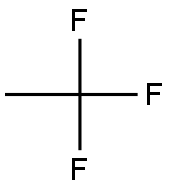
11,1,1-трифторэтан
- английское имя1,1,1-Trifluoroethane
- CAS №420-46-2
- CBNumberCB6853611
- ФормулаC2H3F3
- мольный вес84.04
- EINECS206-996-5
- номер MDLMFCD00013575
- файл Mol420-46-2.mol
| Температура плавления | -111°C |
| Температура кипения | -47°C |
| плотность | 0.942 |
| показатель преломления | 1.2060 |
| Стабильность | Stable. Highly flammable; gas-air mixtures are explosive. |
| LogP | 1.06 at 20℃ |
| Справочник по базе данных CAS | 420-46-2(CAS DataBase Reference) |
| FDA UNII | 84581C5PRN |
| Справочник по химии NIST | Ethane, 1,1,1-trifluoro-(420-46-2) |
| Система регистрации веществ EPA | HFC-143a (420-46-2) |
| Коды опасности | F | |||||||||
| Заявления о рисках | 11 | |||||||||
| Заявления о безопасности | 16-33 | |||||||||
| РИДАДР | 2035 | |||||||||
| Примечание об опасности | Flammable | |||||||||
| TSCA | T | |||||||||
| Класс опасности | 2.1 | |||||||||
| кода HS | 2903392926 | |||||||||
| Банк данных об опасных веществах | 420-46-2(Hazardous Substances Data) | |||||||||
| Токсичность | mma-sat 50 pph/48H TXAPA9 72,15,84 | |||||||||
| NFPA 704: |
|
рисовальное письмо(GHS)
-
рисовальное письмо(GHS)



-
сигнальный язык
опасность
-
вредная бумага
H315:При попадании на кожу вызывает раздражение.
H319:При попадании в глаза вызывает выраженное раздражение.
H335:Может вызывать раздражение верхних дыхательных путей.
H220:Чрезвычайно легковоспламеняющийся газ.
H280:Газ под давлением. Баллоны (емкости) могут взрываться при нагревании.
-
оператор предупредительных мер
P210:Беречь от тепла, горячих поверхностей, искр, открытого огня и других источников воспламенения. Не курить.
P280:Использовать перчатки/ средства защиты глаз/ лица.
11,1,1-трифторэтан химические свойства, назначение, производство
Химические свойства
1,1,1-Trifluoroethane is a colorless gas or a liquid under pressure.Использование
HFC 143a is used as a refrigerant and as a component in some refrigerant blends.Общее описание
1.1.1-Trifluoroethane is a colorless, highly flammable gas. 1,1,1-Trifluoroethane is heavier than air and vapors may travel from a leaking container to a source of ignition causing a flame to flashback to the container. Contact with the unconfined liquid can cause frostbite. Under prolonged exposure to fire or heat the containers may rupture violently and rocket.Реакции воздуха и воды
Highly flammable.Профиль реактивности
Halogenated aliphatic compounds, such as 1,1,1-Trifluoroethane, are moderately or very reactive. Reactivity generally decreases with increased degree of substitution of halogen for hydrogen atoms. Low molecular weight haloalkanes are highly flammable and can react with some metals to form dangerous products. Materials in this group are incompatible with strong oxidizing and reducing agents. Also, they are incompatible with many amines, nitrides, azo/diazo compounds, alkali metals, and epoxides.Угроза здоровью
Vapors may cause dizziness or asphyxiation without warning. Some may be irritating if inhaled at high concentrations. Contact with gas or liquefied gas may cause burns, severe injury and/or frostbite. Fire may produce irritating and/or toxic gases.Пожароопасность
EXTREMELY FLAMMABLE. Will be easily ignited by heat, sparks or flames. Will form explosive mixtures with air. Vapors from liquefied gas are initially heavier than air and spread along ground. CAUTION: Hydrogen (UN1049), Deuterium (UN1957), Hydrogen, refrigerated liquid (UN1966) and Methane (UN1971) are lighter than air and will rise. Hydrogen and Deuterium fires are difficult to detect since they burn with an invisible flame. Use an alternate method of detection (thermal camera, broom handle, etc.) Vapors may travel to source of ignition and flash back. Cylinders exposed to fire may vent and release flammable gas through pressure relief devices. Containers may explode when heated. Ruptured cylinders may rocket.Профиль безопасности
Mutation data reported. Whenheated to decomposition it emits toxic vapors of F??.Возможный контакт
The 1,1,1-isomer is used to make other chemicals and used as a refrigerant.Перевозки
UN2035 1,1,1-Trifluoroethane, compressed or Refrigerant gas, R 143a, Hazard Class: 2.1; Labels: 2.1- Flammable gas. Cylinders must be transported in a secure upright position, in a well-ventilated truck. Protect cylinder and labels from physical damage. The owner of the compressed gas cylinder is the only entity allowed by federal law (49CFR) to transport and refill them. It is a violation of transportation regulations to refill compressed gas cylinders without the express written permission of the owner.Несовместимости
1,1,1-Trifluoroethane forms an explosive mixture with air. Low molecular weight haloalkanes are highly flammable and can react with some metals to form dangerous products. Materials in this group are incompatible with oxidizers (chlorates, nitrates, peroxides, permanganates, perchlorates, chlorine, bromine, fluorine, etc.) and reducing agents such as hydrides, nitrides, alkali metals, and sulfides. Also, they are incompatible with many amines, nitrides, azo/diazo compounds, alkali metals, and epoxides.Утилизация отходов
Return refillable compressed gas cylinders to supplier. Nonrefillable cylinders should be disposed of in accordance with local, state and federal regulations. Allow remaining gas to vent slowly into atmosphere in an unconfined area or exhaust hood. Refillabletype cylinders should be returned to original supplier with any valve caps and outlet plugs secured and valve protection caps in place.11,1,1-трифторэтан запасные части и сырье
11,1,1-трифторэтан Обзор)
- 1,2-Дихлорэтан
- Октафтортолуола
- 3'-(Трифторметил)ацетофенон
- 3'-(трифторметил) ацетанилид
- 3-бромбензотрифторид
- 3-(Трифторметил)анизол
- 3,5-бис (трифторметил) бензонитрил
- 2-бромбензотрифторид
- 3,5-бис(трифторметил)бромбензол
- 3 - (трифторметил) бензофенон
1of4